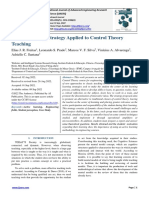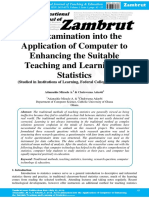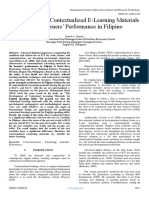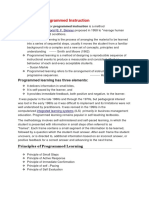Professional Documents
Culture Documents
A Personal Reflection On The Computer Assisted Instruction Online Learning Tutoring
Original Title
Copyright
Available Formats
Share this document
Did you find this document useful?
Is this content inappropriate?
Report this DocumentCopyright:
Available Formats
A Personal Reflection On The Computer Assisted Instruction Online Learning Tutoring
Copyright:
Available Formats
Volume 5, Issue 5, May – 2020 International Journal of Innovative Science and Research Technology
ISSN No:-2456-2165
A Personal Reflection on the Computer Assisted
Instruction: Online Learning Tutoring
Akın Metli
Bilkent Erzurum Laboratory School (BELS)
Erzurum, Turkey
Abstract:- This paper presents personal reflections on As part of one of my elective PhD courses in
the effectiveness and the utilization of computer assisted Curriculum and Instruction at Bilkent University, Current
instruction (CAI) in the basic R statistics and graphing Trends and Issues in Educational Technology, I was
sessions on an online learning tutoring website. My involved in tutoring sessions about a statistics program
personal reflection is focused on the critical analysis of called R on an online portal called Code-School that
CAI as well as my personal reflective experiences in teaches some subject areas especially the web technologies
tutoring sessions on statistics. This paper presents with video lessons, coding challenges and screencasts.
learner experiences with regards to the pros and cons of Code-School is an online learning environment that teaches
CAI and a personal approach to the utilization of CAI a wide range of programming and web design skills.
as a teacher. The reflection paper concludes that CAI Learners can take online classes based on their levels such
can be a good tool to teach basic statistics to attain as from the beginner to advanced and earn rewards and
intended learning objectives for specific learner groups badges as they learn through this online learning system.
provided that the needs, expectations, the levels of the
students, the purpose of the programmed learning, As a trial, I completed 4 of the 8 chapters
specific learning outcomes are identified accurately. compromising the free R statistical software program on
the code-school website. The modules I completed
Keywords:- Computer assisted instruction; Distance successfully were the first chapter (R Syntax) was an
education; Reflective learner; Statistics education introduction to R expressions, variables and functions; the
research. second chapter (Vectors) was about grouping values into
vectors and doing arithmetic and graphs with them; the
I. INTRODUCTION third chapter (Matrices) was about creating and graphing
two-dimensional data sets; the fourth chapter (Summary
With the arrival of the microcomputers in the 1970s, Statistics) was about calculating and plotting some basis
the use of computers at schools has become more statistics such as mean, median and standard deviation.
widespread and has been playing an essential role in
instruction, remediation and further guidance in various When I was completing the tasks, my main objective
learning environments ranging from the pre-K to tertiary was to reflect on the experiences I gained through the
education or post-graduate education levels (Global completion of the tasks and critically reflect upon and
Britannica, 2019). analyze the effectiveness of CAI through the experience of
this statistical program. Therefore, I noted my personal
Computer Assisted Instruction (CAI) is the idea that experiences through reflective logs and evaluated the
the computer is used as an instructional tool in learning. effectiveness of CAI as an alternative to the traditional
Instructional material is presented for instruction or learning environment. For my reflective purposes, I did not
remediation with the help of a computer which enhances pay attention to what I learned in basic statistics or
learning. It is generally used as a tutorial program to mathematics, but elaborated more on my own experiences
reinforce what is learned through question-answer sessions as a learner and critically analyzed the advantages and
in sequential challenging orders with immediate responses disadvantages so as to evaluate the reasons of the use of
and feedback (Computer Assisted Instruction, 2019). CAI as an alternative to traditional instruction.
CAI programs can give learners the opportunity to II. LITERATURE REVIEW
make a progress at their own pace. The learners can work
individually on the presented data/tasks and master the In 1954, Skinner was engaged in some studies to
skills required through different types of activities. The advance teaching and learning techniques for some subject
learners answer the questions or do the tasks and they are areas such as math with the help of a device which would
given immediate feedback for what they have not take over the traditional role of a teacher in a regular
understood thoroughly. They are expected to move ahead classroom experience. Hence, Skinner developed an
until they have got a command of knowledge (Computer educational theory called “programmed learning”
Assisted Instruction, 2019). implemented by “teaching machines”. This is a technique
grounded in behaviorist approach where a learner is
provided with information in a sequential order under
controlled conditions. (Encyclopedia Britannica, 2019).
IJISRT20MAY829 www.ijisrt.com 1317
Volume 5, Issue 5, May – 2020 International Journal of Innovative Science and Research Technology
ISSN No:-2456-2165
Once the student has grasped the first topic by studying the Stultz, 2017) and found out that they provide effective
given information and answering the question(s) correctly, strategies in addressing the learners with certain learning
then he/she is given the chance to carry on the next task. difficulties.
From this point of view, it can be said that the In addition to the studies conducted on the students’
programmed learning is dependent upon steps principle. It enhanced learning outcomes through computer assisted
is generally regarded as a technique that is “self-paced, self- instruction, some other researchers also worked with
administered instruction presented in logical sequence and teachers as research participants to find out their
with much repetition of concepts” and with immediate perspectives on the use of computer assisted instruction as a
reinforcement and feedback for the learner (Skinner, 1958). means of enhancing learning or dealing with disruptive
The teaching machine has a program which includes items student behaviour. For example, Toman, et al., (2013)
to be learned that take students from one task to another conducted research to collect the views of science and
gradually in sequences. The tasks are generally designed to technology teachers in Turkey about computer assisted
be fill in the blank method on a workbook or in a computer. instruction, and found out that most of the teachers did not
If the answer given is correct, the student carries on with use computer assisted instruction practices in their lessons.
the next topic; if incorrect, it requires you to study the topic Mazzotti, et al., (2012) suggested in their study that
again until you answer it correctly for increasing the chance computer-assisted instruction could support teachers for
of reinforcement. Programmed instruction is based on classroom management. This study examined the effects of
Skinner’s operant conditioning. It is a behaviorist theory computer-assisted instruction on students' knowledge of the
which is to do with the idea that learning occurs when there Self-Determined Learning Model of Instruction (SDLMI)
is a change in behavior and behavior is conditioned through and level of disruptive behavior. Results indicated
rewarding the right stimulus-response patterns. increased knowledge of the SDLMI and decreased levels of
disruptive behavior for all participants.
Prior studies in the literature examined extensively the
use of Computer Assisted Instruction (CAI) to develop Yet, in my literature review, there was literally no
students’ certain skills in other academic courses. For personal reflective exercise about the use of computer
example, Habib, et al., (2019) and Sharifi, et al. (2018) assisted instruction with regard to statistics education.
found out that CAI improves students’ English language Therefore, this reflection paper aims to provide authentic
development. Hawkins, et al., (2017) reported that and first-hand reflections on the critical examination of use
computer-assisted instruction is a curriculum supplement of computer assisted instruction through online code-school
for improving math skills, including math fact fluency. on statistics. This paper will present personal perspectives
Keengwe and Hussein (2014) reported that students that on the benefits and barriers on the computer assisted
used computer-assisted classroom instruction gained scores instruction from a teacher of English and Theory of
in reading and math. The use of computer applications as a Knowledge and as a learner/researcher who was enrolled in
supplement to instruction was also suggested as it promotes a Graduate School of Education for PhD program in
student interest and motivation (Macaruso and Walker, Curriculum and Instruction.
2008).
III. CRITICAL ANALYSIS AND EXAMINATION
In addition to the academic courses, students’ learning OF PERSONAL EXPERIENCES
motivations were also studied to explore to what extent
computer assisted instruction can act as a means of A. General Reflection on Personal Experiences regarding
promoting intrinsic and extrinsic motivation. Gambari, et CAI
al., (2016) investigated the role of computer-assisted It was the first time I tried such an online learning tool
instruction in promoting intrinsic and extrinsic motivation and it was quite useful experience in terms of critical
among Nigerian secondary school chemistry students and analysis and evaluation of practicality of computer assisted
found out that students taught with computer simulation learning tools as an alternative to traditional instruction. I
instructional package had higher intrinsic and extrinsic noticed that the Code-School learning portal is very much
motivation. related with the behaviorist approach in the sense that
earning rewards and badges is a direct behavior approach
Studies on computer assisted instruction in the based on Skinners learning theory. It also makes you think
literature varies in terms of the age groups or cognitive of the programmed learning because the online sessions
abilities addressed by researchers. Some researchers (Trotti, include behavioral objectives, small frames of instruction,
et al., 2017) examined the literacy development of self-pacing, active learner response to inserted question and
prekindergarten students in literacy development; whereas, immediate feedback (Skinner, 1958).
Kolpashnikova and Bartolic (2019) conducted a study
involving university students about how implementing My general feeling was that online portals could be
computer-assisted instructional methods increased their regarded as a good means of integrating technology into
knowledge acquisition in quantitative methods. our educational research and learning and making use of it
Furthermore, some studies investigated computer assisted in a meaningful way for our academic interests, research
instruction practices for dealing with the special needs of and learning. As it was self-paced experience and the tasks
learners (Root, et al., 2017; McKissick, 2017; Mutlu, 2017; were ordered in a way that it goes from the easier to the
IJISRT20MAY829 www.ijisrt.com 1318
Volume 5, Issue 5, May – 2020 International Journal of Innovative Science and Research Technology
ISSN No:-2456-2165
challenging, the learners may feel that they are scaffolding All in all, although I greatly enjoyed being exposed
their learning in a sequential order and get reinforced with distance learning through computer assisted instructed on
the help of immediate feedback. In a traditional learning statistics, I felt that shaping students’ attitudes and
environment, teachers may have difficulties in reaching facilitating learning is a complicated process and the tasks
every student to monitor their progress and give designed in orders along with feedback do not expose the
constructive feedback individually. Due to the fact that learners what they already know or build upon what they
each and every individual has their own pace of learning, are able to learn. It is very limited in the sense that the CAI
the needs and expectations of students in a regular shows only a good consideration to shape and reinforce
classroom may vary tremendously. Thus, the students in a responses to be learned. However, learners can benefit from
typical learning environment may lack the reinforcement CAI more by means of more varied tasks, effective
received from the teacher, which might cause some constructive feedback system, effective praising and
possible drawbacks such as the loss of motivation, the lack rewarding, embedding real life examples, providing further
of interest, no demonstration of an ability to make links or guidance when stuck, needs analysis on the learner types
associations with what is learned as well as the risk of and expectations, activating schemata and building upon
falling behind and so forth. That’s why, I thought that these prior knowledge and etc. Furthermore, in my opinion, there
problems can be limited to moderate extent in computer are some implications for further research about the
assisted learning environment by means of providing the comparison between CAI and teacher-led traditional
learners with the opportunity to take their time at their own instruction in terms of the learned responses being quickly
pace, go back and revise the parts which were not forgotten and computer self-efficacy in online learning and
internalized or grasped thoroughly and get reinforced face to face learning environments.
through the completion of tasks with the personalized
constant individual feedback. B. Reflections on Benefits and Barriers of CAI
On the one hand, when I consider the advantages of
Thereby, it can be discussed that the learners’ using CAI, firstly, I can state that as I went through each
behaviors are constructed with the help of reinforcement of and every single task in the sessions, I felt that it was user
intended learning outcomes. Furthermore, since the content friendly in the sense that it was easy for me to navigate in
of the sessions were arranged in very small steps, the the system and find any relevant information I was looking
learners can work on the simple information to master the for.
required skills and challenge himself/herself for a more
complex task. However, if the student is stuck with one of Secondly, the programmed learning technique in R
the tasks and cannot get what the immediate feedback says system allowed me to focus on the subject matter under the
or how to act on the identified problem, then there is high sequence of controlled steps. Activities were graded in
probability that learners may feel disappointed and terms of their difficulty levels and this helped me to be
frustrated as I myself did from time to time. It may be motivated at learning the new material since I thought that
demotivating for learners to see that when they put their was encouraged to take my time, focus on the information
response to go on the next task, they keep getting warning presented briefly, spend time understanding how it works
messages such as “Error: unexpected … Execution halted” and what I am expected to do. The easy tasks gave me the
with no other constructive feedback. In this sense, learners feeling that the tasks are doable and the computer would
may feel that they lose their time in dealing with this type facilitate my learning with its immediate feedback and
of feedback and concentration while trying to cope with chance to go back and revise what was not understood.
understanding the feedback given.
Thirdly, since I was able to work through the
I personally hold the view that the online sessions may programmed material by myself at my own speed and test
not be of practical use when it comes to the assessment of my comprehension by answering questions before moving
students’ understanding. The reason being is that the to the next challenging task, I was able to stop, rest, take
information is presented in the designed sequence steps and my time, go back and revise when necessary, which in turn
the material is only checked through some answers to the gives the learners some flexibility in their learning.
comprehension type of questions given by the computer.
I’d rather I was asked some concept questions, probing Fourthly, I felt that it was very time gaining activity
questions and review questions so that it checks my because the correct answers were shown immediately and
understanding fully. Just because you have answered a additional information was provided, so as a learner, I did
question correctly does not mean that you have fully not need to wait for any other learners in a traditional
mastered this topic. For instance, I have that several of my learning environment to slow down my learning with what
answers were coincidentally accepted as correct and I went I already knew or understood.
on with the next task with no learning. The tasks do not
enhance any higher order thinking skills, but rather one is Fifthly, the specific answers were elicited successfully
expected to recall the information and apply it according to by the computer. Whenever I made a tiny mistake such as a
the given set of information. This may imply that computer typo, it warned me and directed me to put the correct
assisted learning does not reinforce higher order thinking response. I believe it is difficult to check each and every
skills and it may also not activate learners’ prior knowledge single learner’s responses and correct their small mistakes
and encourage them learning by doing in an effective way.
IJISRT20MAY829 www.ijisrt.com 1319
Volume 5, Issue 5, May – 2020 International Journal of Innovative Science and Research Technology
ISSN No:-2456-2165
in a traditional learning environment to avoid any Lastly, I felt that there is no accountability of learning
misconceptions or fossilized mistakes. in this program. CAI programs may foster a student
centered learning atmosphere, but teachers ensure that
Lastly, I thought that in a traditional classroom, there students take active roles and responsibilities of their own
is a high possibility that teachers may not work with each learning by monitoring their progress closely and
and every single student in a crowded class and present facilitating learning with certain techniques and methods. It
them a gradual progression of small units of information is possible that a learner may complete tasks in long time
and related tasks by providing them with specific situation limits unnecessarily or may not be committed to the
or stimulus. However, in CAI experience, learners would intended learning outcomes. In a traditional classroom
actively participate in each task by performing the set task, environment, the teacher could counsel students and
so each student is given a chance for participation as there employ certain strategies to hook up the students’ attention
are no pressure of the time constraints. and make it more meaningful and useful for the students.
However, it is not clear how one can make learners feel
On the other hand, when I consider the disadvantages responsible and accountable for their own learning progress
of using CAI, firstly, I should state that the program was in such an online learning environment.
not interactive enough. The system was very plain with sets
of tasks in order and rigid feedback system. I thought that C. Personal Approach to CAI
the concepts could have been better illustrated or delivered I know that this online platform has some limitations
through attractive animation, sound and demonstration. which were discussed earlier on, but it also has some
insightful ways of approaching the methodological and
Secondly, the learners may feel frustrated when they pedagogical problems in a traditional learning environment.
are unsatisfied by the feedback provided. Some of the Hence, I would positively consider using this online portal
feedback that I received for the tasks that I was not as a teacher to teach basic statistics as long as I would
successful made me really angry because I tried all the change with the structure of the system in a way that it
ways that have come to my mind and I was definitely stuck. allows more positive and effective feedback through
The feedback did not make any sense to me from time to additional information when things seem unclear, prior
time or I did not understand what I was supposed to do. knowledge is activated to make connections and more
Several times, I felt it was very time consuming spending examples are provided when one is stuck. I think I would
hours on a single task. For instance, I had problems in give this learning experience opportunity for further help
figuring out the task: “now see if you can set the value for and guidance to my students. If I designed the programmed
the ‘third’ rank to something other than 3 using the name instruction, I would consider specifying the goal of
rather than the position” and because there was no way of instruction (reinforcement, remedial, further guidance,
paraphrasing it or alternative way of explaining it, it took introduction and etc.) and write the learning objectives
my time to carry on the third session just because of one of more clearly for each module, identify the learners’ levels,
the small tasks in the second session. expectations and needs, make the instruction in small
doable flexible steps with more effective feedback,
Thirdly, when I was going through from one task to appropriate reinforcement and attractive rewarding system.
another, I felt the need for asking questions, getting further
guidance or making some associations with the help of a I would also consider presenting the material in a
facilitator like a teacher. However, the program only more visually appealing navigable structure and provide
allowed me to progress at my own pace and work active learning drills to increase enjoyment of learning. It is
individually for the tasks set. I thought that it would have also worthwhile to give students formative and summative
been better if I was also able to work with my classmates or assessments. For instance, online tutor can give a pre-test
with my teacher for the things I needed further for identifying the learners’ capabilities and a post-test to
clarifications or how to correctly answer the question. assess learners’ progress more closely and more accurately
and keep the records of the scores to revisit the material
Fourthly, although I believe that the program offered when necessary.
me a different type of learning experience and learner
paced learning instead of teacher-led instruction, it did not Additionally, the online tutor can log in the website to
play an essential role in guiding the students when answer specific questions or give further clarifications to
necessary. I think learners may need some extra help and the online users. To me, students who are more interested
support for prompting and hinting in the presentation of the in the technology integration, who do not suffer from
material. The program does not allow the student to anxiety in the use of computers, who prefer more
proceed with the next task unless you answer it correctly. I individualistic approach that is self-paced and directed and
do not think that it checks your understanding and ensures who need more close immediate individual constructive
that you are qualified enough to carry on the next task. feedback could benefit from such a statistics education
Learners may end up with the feeling of dissatisfaction or program greatly.
frustration when they are not even allowed to proceed. In a
traditional learning environment, teachers care about
students’ attitudes in learning and take the necessary
actions to help or guide them.
IJISRT20MAY829 www.ijisrt.com 1320
Volume 5, Issue 5, May – 2020 International Journal of Innovative Science and Research Technology
ISSN No:-2456-2165
IV. CONCLUDING REMARKS [7]. Hawkins, R. O., Collins, T., Hernan, C., & Flowers, E.
(2017). Using Computer-Assisted Instruction to Build
As I worked through the chapters, I tried to explore Math Fact Fluency: An Implementation Guide.
some of the attributes and capabilities of this online Intervention in School and Clinic, 52(3), 141-147.
learning technology. I became more aware of the fact that [8]. Keengwe, J., & Hussein, F. (2014). Using Computer-
this contemporary e-learning environment can be a means Assisted Instruction to Enhance Achievement of
of achieving success in learning if the purpose of this English Language Learners. Education and
system is clarified, the above-mentioned disadvantages or Information Technologies, 19(2), 295-306.
limitations are acted on, the digital platform allows more [9]. Kolpashnikova, K., & Bartolic, S. (2019). Digital
flexibility to the learners and more online guidance or Divide in Quantitative Methods: The Effects of
support is provided by means of forums, question-answer Computer-Assisted Instruction and Students’ Attitudes
sessions, video presentations and so on. From this point of on Knowledge Acquisition. Journal of Computer
view, I hold the view that CAI can be a good instrument to Assisted Learning, 35(2), 208-217.
reach intended learning outcomes in statistics education for [10]. Macaruso, P., & Walker, A. (2008). The efficacy of
learners who prefer working at their own pace, need computer assisted instruction for advancing literacy
individual immediate feedback, have sufficient computer skills in kindergarten students. Reading Psychology,
literacy and who embrace autonomous learner approach. 29, 266–287.
[11]. Mazzotti, V. L., Wood, C. L., Test, D. W., & Fowler,
However, I think it is very important to consider that C. H. (2012). Effects of Computer-Assisted
teachers set the attainable objectives and the purpose of the Instruction on Students’ Knowledge of the Self-
programmed learning clearly, do a needs analysis to Determined Learning Model of Instruction and
structure the online portal more effectively by designing it Disruptive Behavior. Journal of Special Education,
according to the students’ levels, interests, expectations and 45(4), 216-226.
needs. If CAI serves for reinforcement, enhancement or [12]. McKissick, B. R., Diegelmann, K.M., & Parker, S.
enrichment of learning and greater learner autonomy, I (2017). Using Technology to Address Barriers in Rural
believe it should be more flexible in terms of feedback, the Special Education for Students with Autism: A Do-It-
presentation of material and review-revision. Yourself Guide. Rural Special Education Quarterly,
36(3), 155-159.
There is also a need for further research based on the [13]. Mutlu, Y., & Akgün., L. (2017). The Effects of
implications discussed with regards to how the online Computer Assisted Instruction Materials on
portal can be shaped in a way that it may foster higher Approximate Number Skills of Students with
order thinking skills such as analysis, synthesis and Dyscalculia. Turkish Online Journal of Educational
evaluation in statistics education based on the learners’ Technology, 16(2). 119-136.
feedback and their own reflections on their experiences [14]. Root, J. R., Stevenson, B. S., Davis, L. L, Geddes-Hall,
with CAI. J.., & Test, D. W. (2017). Establishing Computer-
Assisted Instruction to Teach Academics to Students
REFERENCES with Autism as an Evidence-Based Practice. Journal of
Autism and Developmental Disorders, 47(2), 275-284
[1]. Computer Assisted Instruction and Reading. Retrieved [15]. Skinner, B. F. (1958). Teaching
from http://www.readingrockets.org/article/4185 Last machines. Science. 128(3330), 969-977.
access 12.11.2019 [16]. Stultz, S. L. (2017). Computer-Assisted Mathematics
[2]. Code-School. Retrieved from Instruction for Students with Specific Learning
https://tryr.codeschool.com/ Last access on 31.03.2019 Disability: A Review of the Literature. Journal of
[3]. Encyclopedia Britannica Programmed Learning. Special Education Technology, 32(4), 210-219.
Retrieved from [17]. Sharifi, M., Rostami A., Ali, A., Jafarigohar, M., &
https://www.britannica.com/topic/programmed- Zandi, B. (2018). Retrospect and Prospect of Computer
learning#ref12911 Last access 30.03.2019 Assisted English Language Learning: A Meta-Analysis
[4]. Gambari, I. A., Gbodi, B. E., Olakanmi, E. U., & of the Empirical Literature. Computer Assisted
Abalaka, E. N. (2016). Promoting Intrinsic and Language Learning, 31(4), 413-436.
Extrinsic Motivation among Chemistry Students Using [18]. Toman, U., Gurbuz, F., & Cimer, S.O. (2013).The
Computer-Assisted Instruction. Contemporary View of Science and Technology Teachers about
Educational Technology, 7(1), 25-46. Computer Assisted Instruction. Mevlana International
[5]. Global Britannica, Computer Assisted Instruction. Journal of Education, 3(2), 77-87.
Retrieved from [19]. Trotti, J., Hendricks, R., & Bledsoe, C. (2017).
https://www.britannica.com/topic/computer-assisted- Emergent Literacy Development and Computer
instruction Last access on 12.11.2019 Assisted Instruction. SRATE Journal, 26(1), 30-39.
[6]. Habib, M. A., Mustapha, M. A., & Ali, H. (2019). Use
of Computer Assisted Instruction to Improve Students’
Reading Skill in English Language. Journal on English
Language Teaching, 9(1), 32-37.
IJISRT20MAY829 www.ijisrt.com 1321
You might also like
- Human Resource Management NotesDocument34 pagesHuman Resource Management Notesmechidream88% (32)
- Elearning Theories & Designs: Between Theory & Practice. a Guide for Novice Instructional DesignersFrom EverandElearning Theories & Designs: Between Theory & Practice. a Guide for Novice Instructional DesignersNo ratings yet
- Project On Effectiveness of Training On Employees PerformanceDocument84 pagesProject On Effectiveness of Training On Employees PerformanceSuvarna RajuNo ratings yet
- Unit Outline: MA5.2-1WM MA5.2-3WM MA5.2-15SP MALS-35SP MALS-36SP MALS-37SPDocument37 pagesUnit Outline: MA5.2-1WM MA5.2-3WM MA5.2-15SP MALS-35SP MALS-36SP MALS-37SPapi-408516407100% (1)
- Modern Teaching Techniques in Education: February 2019Document8 pagesModern Teaching Techniques in Education: February 2019KHALIDOO6No ratings yet
- Introduction To EvaluationDocument9 pagesIntroduction To EvaluationVeronica GuerraNo ratings yet
- Development and Validation of Module inDocument271 pagesDevelopment and Validation of Module inKareen Joy ManglicmotNo ratings yet
- Computer Assisted LearningDocument15 pagesComputer Assisted LearningAnjali Thaloor100% (2)
- Perceived Effectiveness of Artificial Intelligence-Powered Calculators On The Academic Performance of Senior High School STEM Students in MathematicsDocument8 pagesPerceived Effectiveness of Artificial Intelligence-Powered Calculators On The Academic Performance of Senior High School STEM Students in MathematicsPsychology and Education: A Multidisciplinary JournalNo ratings yet
- Revise Manu.Document24 pagesRevise Manu.제너No ratings yet
- Prosidng Kolaborasi SellyDocument5 pagesProsidng Kolaborasi SellyGelageli adminNo ratings yet
- International Journal of Education and Research Vol. 3 No. 2 February 2015Document10 pagesInternational Journal of Education and Research Vol. 3 No. 2 February 2015Purnama AnugerahNo ratings yet
- Chapter 123 Group 4Document13 pagesChapter 123 Group 4BENDAÑA, RYAN M.No ratings yet
- Development of Interactive Physics E-Module To ImpDocument10 pagesDevelopment of Interactive Physics E-Module To ImpHarlene ArabiaNo ratings yet
- Dwijayani 2019 J. Phys. Conf. Ser. 1321 022099Document7 pagesDwijayani 2019 J. Phys. Conf. Ser. 1321 022099Geetha. SNo ratings yet
- Development of Learning Content in Computer Based Media With Articulate Storyline To Improve Civiccs Learning Outcomes in Third Grade Elementary School StudentsDocument8 pagesDevelopment of Learning Content in Computer Based Media With Articulate Storyline To Improve Civiccs Learning Outcomes in Third Grade Elementary School StudentsInternational Journal of Innovative Science and Research TechnologyNo ratings yet
- Development of Cyberblog-Based Intelligent Tutorial System To Improve Students Learning Ability AlgorithmDocument10 pagesDevelopment of Cyberblog-Based Intelligent Tutorial System To Improve Students Learning Ability AlgorithmRail KingNo ratings yet
- Villegas Ch2019Document6 pagesVillegas Ch2019Roberto MorenoNo ratings yet
- ICT's Impact on Education and Teacher TrainingDocument68 pagesICT's Impact on Education and Teacher Trainingsuraj mohananNo ratings yet
- The Development of Physics Learning Instrument Based On Hypermedia and Its Influence On The Student Problem Solving SkillDocument7 pagesThe Development of Physics Learning Instrument Based On Hypermedia and Its Influence On The Student Problem Solving SkillIrvan NRNo ratings yet
- International Journal of Engineering Research and DevelopmentDocument6 pagesInternational Journal of Engineering Research and DevelopmentIJERDNo ratings yet
- Lack of Tools and Computers Effects on CSS Students PerformanceDocument34 pagesLack of Tools and Computers Effects on CSS Students PerformanceDavid QuisayNo ratings yet
- E Module Design A Learning Material With Rowntree and Hannafin Model For Higher EducationDocument4 pagesE Module Design A Learning Material With Rowntree and Hannafin Model For Higher EducationLaras DiasNo ratings yet
- Thesis FinalDocument41 pagesThesis FinalAnonymous pwOxQu100% (1)
- Research Paper (ITP 222) : Group Members: Maldo, Rogelyn Cornejo, Jhay Layag, Jasmin MarieDocument5 pagesResearch Paper (ITP 222) : Group Members: Maldo, Rogelyn Cornejo, Jhay Layag, Jasmin MarieJasmin Marie G. LayagNo ratings yet
- Article - Ni Komang Julia Dewi 2012027001Document13 pagesArticle - Ni Komang Julia Dewi 2012027001julia dewiNo ratings yet
- The Validity E-Module Science Based On Computational Thinking Approach To Improve Logical Thinking SkillsDocument5 pagesThe Validity E-Module Science Based On Computational Thinking Approach To Improve Logical Thinking SkillsInternational Journal of Innovative Science and Research TechnologyNo ratings yet
- 1 s2.0 S2666920X22000352 MainDocument13 pages1 s2.0 S2666920X22000352 MainyudaTP13No ratings yet
- The Online Scaffolding in The Project-Based Learning: Sha LiDocument5 pagesThe Online Scaffolding in The Project-Based Learning: Sha LiIJCNSVol2NO10No ratings yet
- Hybrid Learning Di MatematikaDocument7 pagesHybrid Learning Di MatematikaOperator SMKN10No ratings yet
- Nursing Education Computer Assisted Instruction HistoryDocument14 pagesNursing Education Computer Assisted Instruction Historyjyoti singh100% (1)
- Efforts To Improve Learning Outcomes in Physics Courses of PVTO IKIP PGRI East Kalimantan Students Through Asynchronous Dan Synchronous System (PASS) Approach PDFDocument12 pagesEfforts To Improve Learning Outcomes in Physics Courses of PVTO IKIP PGRI East Kalimantan Students Through Asynchronous Dan Synchronous System (PASS) Approach PDFInternational Journal of Innovative Science and Research TechnologyNo ratings yet
- Application of Problem Based Learning Model Assisted by Augmented Reality Media To Improve Students' High Order Thinking SkillsDocument12 pagesApplication of Problem Based Learning Model Assisted by Augmented Reality Media To Improve Students' High Order Thinking SkillsIsharyadi HasanNo ratings yet
- Group 2 Research ManuscriptDocument51 pagesGroup 2 Research ManuscriptAngelica AlfonsoNo ratings yet
- Active Learning Strategy Applied To Control Theory TeachingDocument8 pagesActive Learning Strategy Applied To Control Theory TeachingIJAERS JOURNALNo ratings yet
- Educ 118Document15 pagesEduc 118api-263015414No ratings yet
- Developing of Students Worksheets Through STEM Approach To Train Critical Thinking SkillsDocument7 pagesDeveloping of Students Worksheets Through STEM Approach To Train Critical Thinking SkillsLola JovitaNo ratings yet
- Research 2Document25 pagesResearch 2loc dinhNo ratings yet
- Building ICT Competence Through PBLDocument56 pagesBuilding ICT Competence Through PBLGyasi YamoahNo ratings yet
- Ciadmin, Journal Manager, 1649-6536-1-CEDocument6 pagesCiadmin, Journal Manager, 1649-6536-1-CEFearl Hazel Languido BerongesNo ratings yet
- Teachers Perception of Computer Supported Problem Solving: An Italian ResearchDocument9 pagesTeachers Perception of Computer Supported Problem Solving: An Italian ResearchLuca Seriously Ahead TateoNo ratings yet
- UJERCTDocument7 pagesUJERCTsaturinasdiane06No ratings yet
- Computer TeachingDocument10 pagesComputer TeachingCarlos YeboahNo ratings yet
- CAI Improves Learning Skills for Students with DisabilitiesDocument3 pagesCAI Improves Learning Skills for Students with DisabilitiesSamielyn Ingles RamosNo ratings yet
- Effectiveness of Contextualized E-Learning Materials To The Learners' Performance in FilipinoDocument4 pagesEffectiveness of Contextualized E-Learning Materials To The Learners' Performance in FilipinoInternational Journal of Innovative Science and Research TechnologyNo ratings yet
- THESISDocument47 pagesTHESISMary Cris TandocNo ratings yet
- Armero Contextualized E-Learning Resource A Tool For Stronger Academic PlatformDocument7 pagesArmero Contextualized E-Learning Resource A Tool For Stronger Academic PlatformEmerson Taneo ArmeroNo ratings yet
- GARDOSE-Increasing Mathematics Performance of Grade 8 Learners Through Computer-Based Interactive Learning ActivitiesDocument22 pagesGARDOSE-Increasing Mathematics Performance of Grade 8 Learners Through Computer-Based Interactive Learning ActivitiesKaren GardoseNo ratings yet
- Towards A Modern-Day Teaching Machine: The Synthesis of Programmed Instruction and Online EducationDocument10 pagesTowards A Modern-Day Teaching Machine: The Synthesis of Programmed Instruction and Online EducationAna Alice Reis PierettiNo ratings yet
- The Design of A Rule Base For An E-Learning RecommDocument6 pagesThe Design of A Rule Base For An E-Learning RecommTeacher GrasiNo ratings yet
- Critical Journal Review of ICT-Supported Learning DesignDocument4 pagesCritical Journal Review of ICT-Supported Learning DesignTika NurjannahNo ratings yet
- Igloria F Canonigo Educ 118 Lesson OutlineDocument14 pagesIgloria F Canonigo Educ 118 Lesson Outlineapi-267898429No ratings yet
- Wu Et Al 2023 Promoting Self Regulation Progress and Knowledge Construction in Blended Learning via Chatgpt BasedDocument29 pagesWu Et Al 2023 Promoting Self Regulation Progress and Knowledge Construction in Blended Learning via Chatgpt BasedgdimportysNo ratings yet
- Kearney & Burke & Schuck (2019) The iPAC ScaleDocument14 pagesKearney & Burke & Schuck (2019) The iPAC Scalemaria.diazvalencia.goetheNo ratings yet
- Integrating Computers in High School CurriculumDocument95 pagesIntegrating Computers in High School CurriculumAngeline LimetaNo ratings yet
- 1229-Article Text-2323-1-10-20220818 PDFDocument5 pages1229-Article Text-2323-1-10-20220818 PDFKunal AggarwalNo ratings yet
- Google Classroom boosts data mining learningDocument4 pagesGoogle Classroom boosts data mining learningIvan Dale MendozaNo ratings yet
- The Use of Android-Based Phet Simulation As An Effort To Improve Students' Critical Thinking Skills During The Covid-19 PandemicDocument11 pagesThe Use of Android-Based Phet Simulation As An Effort To Improve Students' Critical Thinking Skills During The Covid-19 PandemicArthaNo ratings yet
- Hari Ganesh 2015Document6 pagesHari Ganesh 2015AsmaNo ratings yet
- Active Learning Methodologies For Teaching Programming in Undergraduate Courses: A Systematic Mapping StudyDocument42 pagesActive Learning Methodologies For Teaching Programming in Undergraduate Courses: A Systematic Mapping StudyKris LatuperissaNo ratings yet
- Development of Computer Assisted Instruction (CAI) in College StatisticsDocument28 pagesDevelopment of Computer Assisted Instruction (CAI) in College StatisticsAmadeus Fernando M. Pagente100% (2)
- Smart Cities Research and Student Performance PredictionDocument8 pagesSmart Cities Research and Student Performance PredictionAnjana SNo ratings yet
- JISEv23n1p71 PDFDocument14 pagesJISEv23n1p71 PDFEdmonNo ratings yet
- Dissertation Blended LearningDocument6 pagesDissertation Blended LearningWebsitesToTypePapersNorthLasVegas100% (1)
- Computers & Education: Maya Israel, Jamie N. Pearson, Tanya Tapia, Quentin M. Wherfel, George ReeseDocument17 pagesComputers & Education: Maya Israel, Jamie N. Pearson, Tanya Tapia, Quentin M. Wherfel, George Reesedwi oktaviaNo ratings yet
- IGI - Revised - Manuscript CleanCopy With TablesDocument40 pagesIGI - Revised - Manuscript CleanCopy With TablesFlorin CojocaruNo ratings yet
- Parastomal Hernia: A Case Report, Repaired by Modified Laparascopic Sugarbaker TechniqueDocument2 pagesParastomal Hernia: A Case Report, Repaired by Modified Laparascopic Sugarbaker TechniqueInternational Journal of Innovative Science and Research TechnologyNo ratings yet
- Smart Health Care SystemDocument8 pagesSmart Health Care SystemInternational Journal of Innovative Science and Research TechnologyNo ratings yet
- Visual Water: An Integration of App and Web to Understand Chemical ElementsDocument5 pagesVisual Water: An Integration of App and Web to Understand Chemical ElementsInternational Journal of Innovative Science and Research TechnologyNo ratings yet
- Air Quality Index Prediction using Bi-LSTMDocument8 pagesAir Quality Index Prediction using Bi-LSTMInternational Journal of Innovative Science and Research TechnologyNo ratings yet
- Smart Cities: Boosting Economic Growth through Innovation and EfficiencyDocument19 pagesSmart Cities: Boosting Economic Growth through Innovation and EfficiencyInternational Journal of Innovative Science and Research TechnologyNo ratings yet
- Parkinson’s Detection Using Voice Features and Spiral DrawingsDocument5 pagesParkinson’s Detection Using Voice Features and Spiral DrawingsInternational Journal of Innovative Science and Research TechnologyNo ratings yet
- Predict the Heart Attack Possibilities Using Machine LearningDocument2 pagesPredict the Heart Attack Possibilities Using Machine LearningInternational Journal of Innovative Science and Research TechnologyNo ratings yet
- Impact of Silver Nanoparticles Infused in Blood in a Stenosed Artery under the Effect of Magnetic Field Imp. of Silver Nano. Inf. in Blood in a Sten. Art. Under the Eff. of Mag. FieldDocument6 pagesImpact of Silver Nanoparticles Infused in Blood in a Stenosed Artery under the Effect of Magnetic Field Imp. of Silver Nano. Inf. in Blood in a Sten. Art. Under the Eff. of Mag. FieldInternational Journal of Innovative Science and Research TechnologyNo ratings yet
- An Analysis on Mental Health Issues among IndividualsDocument6 pagesAn Analysis on Mental Health Issues among IndividualsInternational Journal of Innovative Science and Research TechnologyNo ratings yet
- Compact and Wearable Ventilator System for Enhanced Patient CareDocument4 pagesCompact and Wearable Ventilator System for Enhanced Patient CareInternational Journal of Innovative Science and Research TechnologyNo ratings yet
- Implications of Adnexal Invasions in Primary Extramammary Paget’s Disease: A Systematic ReviewDocument6 pagesImplications of Adnexal Invasions in Primary Extramammary Paget’s Disease: A Systematic ReviewInternational Journal of Innovative Science and Research TechnologyNo ratings yet
- Terracing as an Old-Style Scheme of Soil Water Preservation in Djingliya-Mandara Mountains- CameroonDocument14 pagesTerracing as an Old-Style Scheme of Soil Water Preservation in Djingliya-Mandara Mountains- CameroonInternational Journal of Innovative Science and Research TechnologyNo ratings yet
- Exploring the Molecular Docking Interactions between the Polyherbal Formulation Ibadhychooranam and Human Aldose Reductase Enzyme as a Novel Approach for Investigating its Potential Efficacy in Management of CataractDocument7 pagesExploring the Molecular Docking Interactions between the Polyherbal Formulation Ibadhychooranam and Human Aldose Reductase Enzyme as a Novel Approach for Investigating its Potential Efficacy in Management of CataractInternational Journal of Innovative Science and Research TechnologyNo ratings yet
- Insights into Nipah Virus: A Review of Epidemiology, Pathogenesis, and Therapeutic AdvancesDocument8 pagesInsights into Nipah Virus: A Review of Epidemiology, Pathogenesis, and Therapeutic AdvancesInternational Journal of Innovative Science and Research TechnologyNo ratings yet
- Harnessing Open Innovation for Translating Global Languages into Indian LanuagesDocument7 pagesHarnessing Open Innovation for Translating Global Languages into Indian LanuagesInternational Journal of Innovative Science and Research TechnologyNo ratings yet
- The Relationship between Teacher Reflective Practice and Students Engagement in the Public Elementary SchoolDocument31 pagesThe Relationship between Teacher Reflective Practice and Students Engagement in the Public Elementary SchoolInternational Journal of Innovative Science and Research TechnologyNo ratings yet
- Investigating Factors Influencing Employee Absenteeism: A Case Study of Secondary Schools in MuscatDocument16 pagesInvestigating Factors Influencing Employee Absenteeism: A Case Study of Secondary Schools in MuscatInternational Journal of Innovative Science and Research TechnologyNo ratings yet
- Dense Wavelength Division Multiplexing (DWDM) in IT Networks: A Leap Beyond Synchronous Digital Hierarchy (SDH)Document2 pagesDense Wavelength Division Multiplexing (DWDM) in IT Networks: A Leap Beyond Synchronous Digital Hierarchy (SDH)International Journal of Innovative Science and Research TechnologyNo ratings yet
- Diabetic Retinopathy Stage Detection Using CNN and Inception V3Document9 pagesDiabetic Retinopathy Stage Detection Using CNN and Inception V3International Journal of Innovative Science and Research TechnologyNo ratings yet
- Advancing Healthcare Predictions: Harnessing Machine Learning for Accurate Health Index PrognosisDocument8 pagesAdvancing Healthcare Predictions: Harnessing Machine Learning for Accurate Health Index PrognosisInternational Journal of Innovative Science and Research TechnologyNo ratings yet
- Auto Encoder Driven Hybrid Pipelines for Image Deblurring using NAFNETDocument6 pagesAuto Encoder Driven Hybrid Pipelines for Image Deblurring using NAFNETInternational Journal of Innovative Science and Research TechnologyNo ratings yet
- Formulation and Evaluation of Poly Herbal Body ScrubDocument6 pagesFormulation and Evaluation of Poly Herbal Body ScrubInternational Journal of Innovative Science and Research TechnologyNo ratings yet
- The Utilization of Date Palm (Phoenix dactylifera) Leaf Fiber as a Main Component in Making an Improvised Water FilterDocument11 pagesThe Utilization of Date Palm (Phoenix dactylifera) Leaf Fiber as a Main Component in Making an Improvised Water FilterInternational Journal of Innovative Science and Research TechnologyNo ratings yet
- The Making of Object Recognition Eyeglasses for the Visually Impaired using Image AIDocument6 pagesThe Making of Object Recognition Eyeglasses for the Visually Impaired using Image AIInternational Journal of Innovative Science and Research TechnologyNo ratings yet
- The Impact of Digital Marketing Dimensions on Customer SatisfactionDocument6 pagesThe Impact of Digital Marketing Dimensions on Customer SatisfactionInternational Journal of Innovative Science and Research TechnologyNo ratings yet
- Electro-Optics Properties of Intact Cocoa Beans based on Near Infrared TechnologyDocument7 pagesElectro-Optics Properties of Intact Cocoa Beans based on Near Infrared TechnologyInternational Journal of Innovative Science and Research TechnologyNo ratings yet
- A Survey of the Plastic Waste used in Paving BlocksDocument4 pagesA Survey of the Plastic Waste used in Paving BlocksInternational Journal of Innovative Science and Research TechnologyNo ratings yet
- Cyberbullying: Legal and Ethical Implications, Challenges and Opportunities for Policy DevelopmentDocument7 pagesCyberbullying: Legal and Ethical Implications, Challenges and Opportunities for Policy DevelopmentInternational Journal of Innovative Science and Research TechnologyNo ratings yet
- Comparatively Design and Analyze Elevated Rectangular Water Reservoir with and without Bracing for Different Stagging HeightDocument4 pagesComparatively Design and Analyze Elevated Rectangular Water Reservoir with and without Bracing for Different Stagging HeightInternational Journal of Innovative Science and Research TechnologyNo ratings yet
- Design, Development and Evaluation of Methi-Shikakai Herbal ShampooDocument8 pagesDesign, Development and Evaluation of Methi-Shikakai Herbal ShampooInternational Journal of Innovative Science and Research Technology100% (3)
- FOUNDATIONS OF PROGRAMMED INSTRUCTIONDocument26 pagesFOUNDATIONS OF PROGRAMMED INSTRUCTIONMurali CkNo ratings yet
- 42 (2012) 6228-6231Document4 pages42 (2012) 6228-6231Ronaleen mislang100% (1)
- Curso Eddy Current PDFDocument300 pagesCurso Eddy Current PDFsgsdgsdNo ratings yet
- Programed InstructionDocument18 pagesProgramed InstructionGayathri RNo ratings yet
- Linear Programme InstructionDocument17 pagesLinear Programme InstructionMadiha Athar0% (1)
- Action Plan Project CAREDocument4 pagesAction Plan Project CAREextraordinyariNo ratings yet
- Pamt Notes MidtermDocument12 pagesPamt Notes MidtermNicole EusebioNo ratings yet
- Training & Development of Employees With Reference To VitsDocument52 pagesTraining & Development of Employees With Reference To VitsAbhay JainNo ratings yet
- Notes Educational Technology B. Ed. 1-5Document9 pagesNotes Educational Technology B. Ed. 1-5Mehmood HassanNo ratings yet
- Open navigation-WPS OfficeDocument22 pagesOpen navigation-WPS Officermconvidhya sri2015No ratings yet
- Leniar ProgrammingDocument5 pagesLeniar Programmingvikashsingh9116No ratings yet
- Programmed InstructionDocument2 pagesProgrammed InstructionArmand Añonuevo MañiboNo ratings yet
- Programmed InstructionDocument7 pagesProgrammed Instructionblast2111No ratings yet
- Educational Technology 1Document19 pagesEducational Technology 1Ma. Emely PondareNo ratings yet
- Instructional Design-Learning TheoryDocument32 pagesInstructional Design-Learning Theorymkderwish0% (1)
- EDCN-704C-Educational TechnologyDocument248 pagesEDCN-704C-Educational TechnologyJoséHoraNo ratings yet
- Acknowledgement: A Study On Effectiveness of Training On Employee PerformanceDocument53 pagesAcknowledgement: A Study On Effectiveness of Training On Employee PerformancepramodNo ratings yet
- History of Instructional DesignDocument14 pagesHistory of Instructional Designtony_h1100% (1)
- Definition of Programmed Instruction: Programmed Learning Has Three ElementsDocument4 pagesDefinition of Programmed Instruction: Programmed Learning Has Three ElementsyounisNo ratings yet
- Behaviorism: What Role Does Technology Play in This?Document14 pagesBehaviorism: What Role Does Technology Play in This?Jason Orolfo Salvadora HLNo ratings yet
- The Behavioral School of Thought: Let Review, Cor Jesu College Principles of TeachingDocument29 pagesThe Behavioral School of Thought: Let Review, Cor Jesu College Principles of TeachingMary Grace Cernechez100% (1)
- Chapter 2 - Approaches To Educational TechnologiesDocument12 pagesChapter 2 - Approaches To Educational TechnologiesJiezl Mae PanaguitonNo ratings yet
- Research Into Teaching Methods in Higher Education: 4th EditionDocument160 pagesResearch Into Teaching Methods in Higher Education: 4th Editioncẩm túNo ratings yet
- HR Chapter8 PDFDocument30 pagesHR Chapter8 PDFDee WangNo ratings yet























































































































